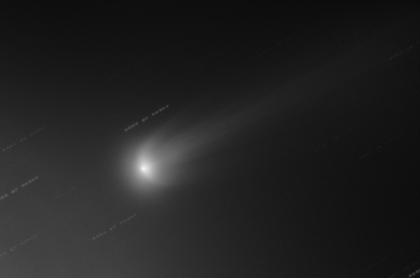Press Release 19/2013 - November 19, 2013
Comet ISON unfolds its wings
New images of ISON indicate that the comet lost individual fragments in the past days.
One or more fragments may have detached from comet ISON in the past days, as two wing-shaped features in the comet's atmosphere suggest. Scientists from the Max Planck Institute for Solar System Research (MPS) in Germany and the Wendelstein Observatory of the Ludwig-Maximilians-University in Munich (Germany) discovered these features in images taken at the end of last week. The fragmentation may offer an explanation for the comet's recent outburst of activity.
On its journey towards the Sun, comet ISON has disappointed many hobby astronomers in the past weeks: its brightness did not increase as strongly as previously assumed. On November 28th, 2013 the comet will fly by the Sun in a distance of only 1.8 million kilometers. However, on November 7th, ISON's light intensity increased abruptly; several observers announced a sudden rise in the comet's activity.

|
Figure 1: This image taken on November 16th, 2013 shows ISON's atmosphere with two wing-like features resembling the letter U. For orientation, the comet's nucleus position is shown as a bright spot in the center.
|
(Credits: Wendelstein Observatory of the LMU/MPS)
|
Images of ISON taken by scientists from the MPS and the Wendelstein Observatory now offer possible evidence for the cause of this outburst. On November 14th and 16th, 2013 the researchers aimed their telescope towards the approaching visitor.
The researchers' analyses show two striking features within the comet's atmosphere that protrude from the nucleus in a wing-like fashion. While these so-called coma wings were still rather faint on November 14th, they dominate the images taken two days later. "Features like these typically occur after individual fragments break off the nucleus", Dr. Hermann Böhnhardt from the MPS explains.
As does the nucleus, these fragments emit gas and dust. Where the emissions from the comet and its fragments meet, a kind of boundary layer is formed that often takes a wing-like form as seen from Earth. Whether or not this fragmentation process led to the recent outburst cannot be determined with certainty, says Bönhardt. However, in the cases of other comets, a connection between both phenomena has been well established.
In the images taken of comet ISON, the coma wings cannot be seen with the naked eye. Instead, numerical methods were necessary to make them visible. To this end the researchers comb through the comet's coma looking for spatial changes in the light intensity. The uniformly bright background of the comet's atmosphere is numerically eliminated so as not to outshine the fainter structures hidden beneath. "Our calculations imply that ISON lost only one fragment or very few at the most", says Böhnhardt.
How the comet will develop in the next weeks is still unclear. "However, according to past experience, comets that have once lost a fragment tend to do this again", says Böhnhardt.
Contact
Dr. Birgit Krummheuer
Press and Public Relations
Max Planck Institute for Solar System Research
Max-Planck-Straße 2
37191 Katlenburg-Lindau
Tel.: 05556 979 462
Fax: 05556 979 240
Mobil: 0173 3958625
Email: krummheuer mps.mpg.de
mps.mpg.de
Dr. Hermann Böhnhardt
Max Planck Institute for Solar System Research
Max-Planck-Straße 2
37191 Katlenburg-Lindau
Tel.: 05556 979 545
Email: Boehnhardt mps.mpg.de
mps.mpg.de
